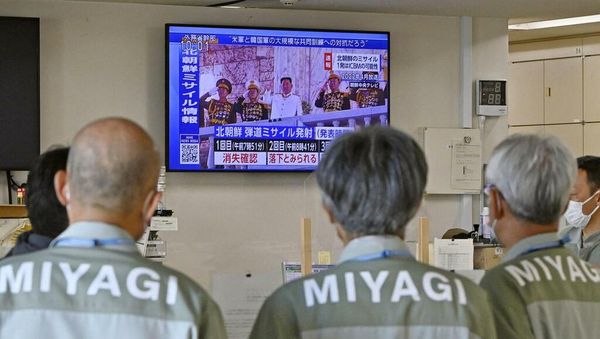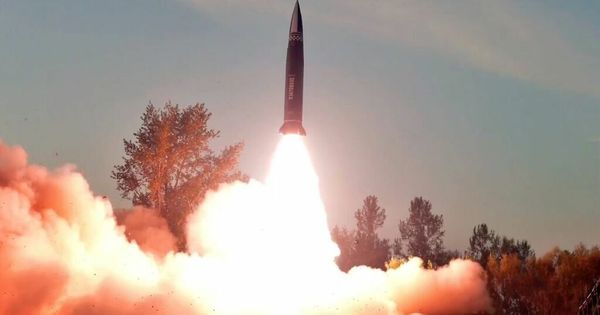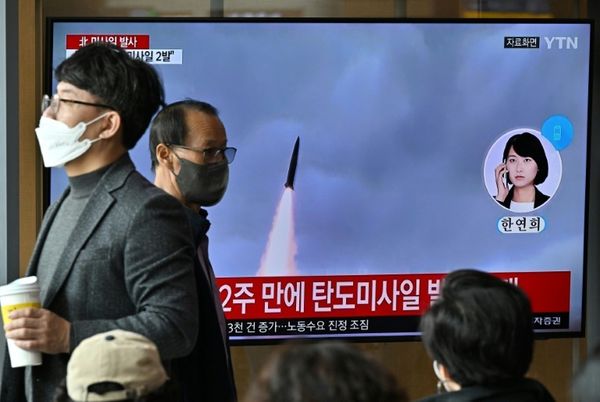
North Korea has fired multiple missiles, including a failed suspected intercontinental ballistic missile (ICBM) that forced the Japanese government to issue evacuation alerts in the northern and central parts of the country.
The launches on Thursday are the latest in a series of North Korean weapons tests in recent months that have raised tensions in the region. They come a day after Pyongyang fired more than 20 missiles, the most in a single day, including one that landed off South Korea’s coast for the first time and prompted Seoul to fire air-to ground missiles in response.
Despite an initial government warning that a missile had overflown Japan, Tokyo later said this was incorrect.
Earlier in the morning, the office of Prime Minister Fumio Kishida had issued warnings to residents in the northern and central prefectures of Miyagi, Yamagata and Niigata, instructing them to take shelter inside firm buildings or underground. Bullet train services in those regions were temporarily suspended following the missile alert before resuming shortly.
Kishida, who said the first missile launched may have been an ICBM, condemned North Korea’s tests and said officials were analysing the details of the weapons.
“North Korea’s repeated missile launches are an outrage and absolutely cannot be forgiven,” he added.
The United States said the launch was a clear breach of UN resolutions.
“This action underscores the need for all countries to fully implement (North Korea) related UN Security Council resolutions, which are intended to prohibit (North Korea) from acquiring the technologies and materials needed to carry out these destabilizing tests,” a State Department spokesperson said in a statement.
Failed ICBM launch
Japanese Defence Minister Yasukazu Hamada said the first missile was launched at about 7.40am (22:40 GMT on Wednesday) on a potential trajectory over Japan but that it disappeared from radars over the Sea of Japan.
“We detected a launch that showed the potential to fly over Japan and therefore triggered the J Alert, but after checking the flight we confirmed that it had not passed over Japan,” Hamada told reporters.
The missile flew to an altitude of about 2,000 km (1,200 miles) and a range of 750 km (460 miles), he said. Such a flight pattern is called a “lofted trajectory”, in which a missile is fired high into space to avoid flying over neighbouring countries.
About half an hour after the launch was first reported, Japan’s Coast Guard said the missile had fallen.
Retired Vice Admiral and former Japan Maritime Self Defense Force fleet commander Yoji Koda said that the loss of radar tracking on the projectile pointed to a failed launch.
“It means at some point in the flight path there was some problem for the missile and it actually came apart,” he said.
Although the warhead came down in the sea between the Korean peninsula and Japan, debris, which would have been travelling at high speed, may still have passed over Japan, Koda added.
The Yonhap News Agency reported the first missile went through stage separation, suggesting it could have been a long-range weapon such as an ICBM. But following the second stage separation, the missile seemed to have failed in normal flight, a South Korean defence source was quoted as saying later.
South Korea’s Joint Chiefs of Staff said the long-range missile was launched from near the North Korean capital of Pyongyang.
About an hour after the first launch, South Korea’s military and the Japanese coast guard reported a second and third launch from North Korea. South Korea said both of those were short-range missiles fired from Kaechon, north of Pyongyang.
On October 4, North Korea launched a ballistic missile over Japan for the first time in five years, prompting a warning for residents to take cover. It was the farthest Pyongyang had ever fired a missile.
North Korea has conducted a record number of weapons launches this year and the latest come amid ongoing large-scale military exercises between the United States and South Korea, which Pyongyang claims are a “provocation”.
The drills, known as Vigilant Storm, involve some 240 warplanes, including F-35 fighters, staging around-the-clock simulated missions.
“Many of North Korea’s missile flights are direct violations of United Nations Security Council resolutions, but its current provocation cycle is unlikely to peak until Pyongyang conducts its long-anticipated seventh nuclear test,” said Leif-Eric Easely, a professor at the Ehwa University in Seoul, South Korea.
“The Kim regime may relish international anxiety in the lead-up to its next nuclear detonation, believing that greater global attention will hasten begrudging acceptance of North Korea as a nuclear weapons state,” he added.
Pyongyang last conducted a nuclear test in 2017.










